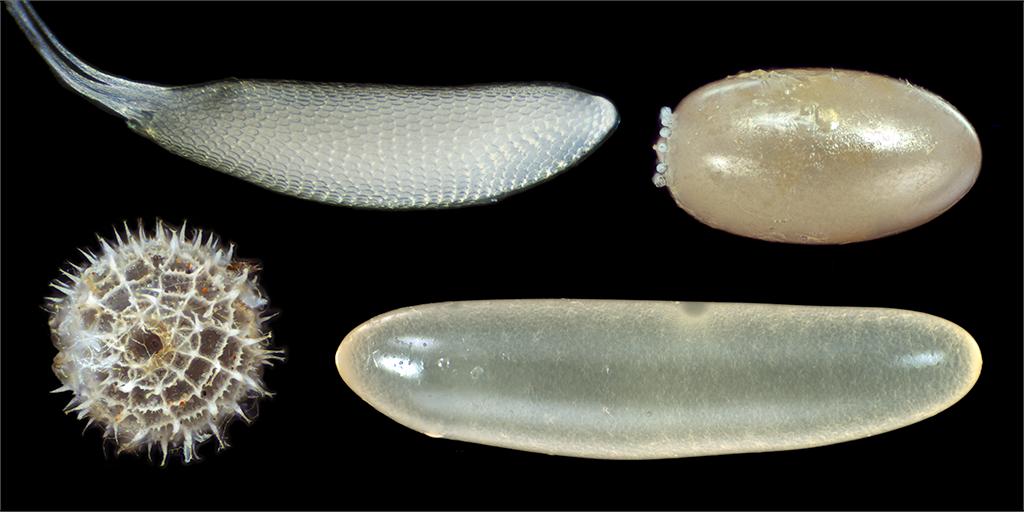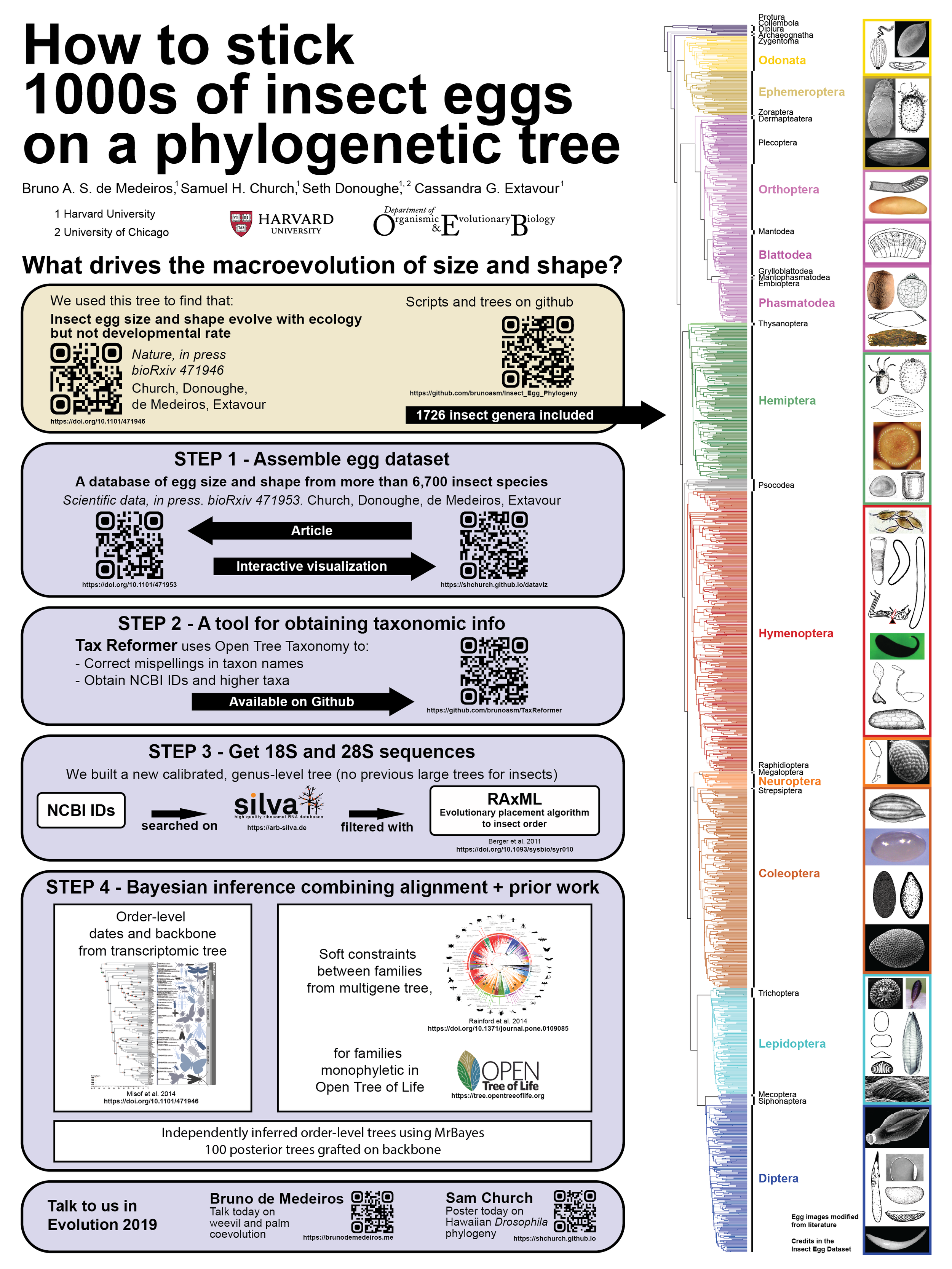I just joined the great team of Associate Editors of Invertebrate Systematics. The journal publishes significant research on on the systematics, phylogeny and biogeography of all invertebrate taxa, and I am especially looking forward to handling papers on insects.
Postdoc at STRI
Tauana Cunha and I just started new postdocs at the Smithsonian Tropical Research Institute. Here I will be studying the fauna of weevils associated with palms, and especially the brood pollination mutualism involving palms in the genus Oenocarpus and Anchylorhynchus weevils. Updates to follow as the project progresses!
Entomology 2019 Meeting
It is palm flowering season in South America, but since I cannot catch bugs this year and I will be talking and watching talks about bugs.
I will be giving talks on target enrichment with PCR-based probes at the meeting of the Entomological Collections Network and the main entomology meeting, and also on how we can use genomics to determine weevil diet breadths in the SOGA Weevil Workers meeting.
Some of the palm weevils interacting with the about 60 species of palms that I sampled in the last few years.
New species of Aristolochia of Hispaniola
The first paper on the collaboration on the Aristolochia of the island of Hispaniola just came out. Here we are reviewing the literature and describing some of the new species recognized. I am currently working on a RAD-seq dataset to test species limits within the genus, so there will be more coming!
Fernández E, Ferreras I, Farrell BD, de Medeiros BAS, Romero-González GA. 2019. Studies in Aristolochia (Aristolochiaceae) of Hispaniola. Phytotaxa 420: 1–20.
Student Views published on ReVista
ReVista, the Harvard Review on Latin America, has a new section written by PhD students and recent graduates. I wrote a small piece on my research on palm weevils and how that led to get involved in the Amazon 4.0 Initiative.
The article is available here:
https://revista.drclas.harvard.edu/book/bruno-de-medeiros-insects-plants-and-challenges-ahead
Two little chicken made of licuri nuts, a gift that I received from Carine Rubinho and her dad while doing fieldwork in Serrinha, Bahia, Brazil
Insect egg evolution papers published
In December 2015, Seth Donoughe and Sam Church invited me to chat about an insect egg size project they were just starting. We talked about their ideas on assembling a very large dataset of insect eggs and how we could build and use a phylogeny to study their evolution. Fast-forward 3.5 years and that ideia become two beautiful papers that were just published today. It was really fun to work with them and Cassandra Extavour to discover all the craziness of insect eggs. As most entomologists, before we started I paid much less attention to the egg life stage than it deserves. I hope that now that this dataset is available people will appreciate how diverse insects are in all life stages and the community we will discover much more about insect eggs!
Here is a twitter thread explaining what we did: https://twitter.com/seth_donoughe/status/1146469955380137984
Church SH, Donoughe S, de Medeiros BAS, Extavour CG. 2019. Insect egg size and shape evolve with ecology but not developmental rate. Nature 571:58-62. DOI: 10.1038/s41586-019-1302-4
Church SH, Donoughe S, de Medeiros BAS, Extavour CG. 2019. A dataset of egg size and shape from more than 6,700 insect species. Scientific Data 6:104. DOI: 10.1038/s41597-019-0049-y
Four different insect eggs (a fly, a true bug, a butterfly and a cricket). Images by Seth Donoughe and Sam Church
Palm weevils and insect eggs at Evolution Meeting 2019
I realized talking to a friend today that this is my first Evolution Meeting in the USA. Previously, I've attended only the ones held in Ottawa, Canadá and in Guarujá, Brazil! It is a really fun meeting, great to catch up with friends and colleagues studying all sorts of creatures to understand their evolution.
This time I will be talking about my work on the early stages of diversification of palm weevils, where I found very similar patterns regardless of the outcomes of interactions with their host plants. That is, it does not matter if a weevil is a beneficial, harmful or harmless to the plant: patterns of genetic differentiation between populations are very similar. This indicates that maybe we should shift the focus away from plant defenses when thinking about the origins of the outstanding diversity of plant-feeding insects, and consider other aspects of host plant use that lead to specialization.
I will also be presenting a poster detailing the methods that we have used to build a phylogenetic tree to study the evolution of insect eggs. The paper will come out in the next few days, and hopefully the methods (especially Tax Reformer) or the tree will also be useful to others! Here is the poster attached for those who cannot make it to Evolution:
Data as Development Workshop
Tomorrow, May 23, I will be speaking in the workshop Data as Development, organized by Yaso Córdova and Lorrayne Porciuncula from the Berkman Klein Center for Internet and Society of Harvard University.
It will be fun to discuss with data scientists and entrepreneurs about the possibilities of using biodiversity data, and particularly genomic data, for development in biodiversity-rich countries.
Diversity of vascular plants (and bugs and pretty much any other organism) is much higher in the tropics. Image source: Mutke J et al (2010). European Plant diversity in the global context.
Registration open for climate change conference
I am one of the co-organizers of a conference on Amazonia and Climate Change that will take place at Harvard on May 7-8. Registration is free and open to the public, by clicking here.
Climate change is one of the most important long-term threats for the future of our societies. Solutions are complex, depending not only on engineering and policy, but also on imagination and public will towards alternative forms of inhabiting the planet. Latin America, home to the largest rainforest areas in the world, is both at risk of environmental catastrophe and a key region in which models for thriving bioeconomies based on rainforests can evolve. This symposium will bring together experts and leaders from the US and Latin America to discuss the past, present and future of Amazonia. We will discuss deforestation trends and their interactions with climate and health; how to move beyond our lack of imagination for viable futures, including the importance and role of indigenous peoples of the Amazon; and ongoing and emerging initiatives towards river-flowing, rainforest-based economies across Amazonia.
Ilha do Combu, near Belém, Pará, Brazil, when I visited in 2012
Cotithene gorayebi, a new pollinator of cyclanths
Cyclanthaceae is a plant family that kind of looks like palms, but are unrelated. They are generally pollinated by beetles, and many of the species specifically by weevils. One the genera of weevils typically found in these flowers is Cotithene, but all species described to date do not seem to be pollinators, only florivores. They are not very abundant, their behavior does not synchronize with flowering times and they are too big to fit into the small spaces the lead to receptive female flowers. In this paper we describe a new species: Cotithene gorayebi, and also show that it is a pollinator of a cyclanth: Evodianthus funifer. This new species is smaller than other species of Cotithene, very abundant and comes and goes from flowers at the right timing to be a good pollinator.
Individuals of Cotithene gorayebi resting in the little spaces between male flowers, where the female flowers are.
Valente RM, da Silva PAL & de Medeiros BAS. 2019. The first species of Cotithene Voss (Coleoptera: Curculionidae: Curculioninae) from Amazonian Brazil, with notes on its role as a pollinator of Evodianthus funifer (Poit.) Lindm. (Cyclanthaceae). Zootaxa 4576: 461-482. doi: 10.11646/zootaxa.4576.3.3
Paper on licuri palm flower visitors is out
Here we describe the details of interactions between several species of insects and the licuri palm Syagrus coronata. Surprisingly, a very interesting pollination mutualism has been hiding in plain sight: these plants are both pollinated by generalist bees and by specialized beetles. Some of these beetle breed on the same flowers they just pollinated. This is the first one in a series on the evolutionary consequences of insect-plant interactions.
de Medeiros BAS, Núñez-Avellaneda LA, Hernandez AM, Farrell BD. 2019. Flower visitors of the licuri palm ( Syagrus coronata ): brood pollinators coexist with a diverse community of antagonists and mutualists. Biological Journal of the Linnean Society. doi:10.1093/biolinnean/blz008.
Beetle species waiting for male flower opening.











